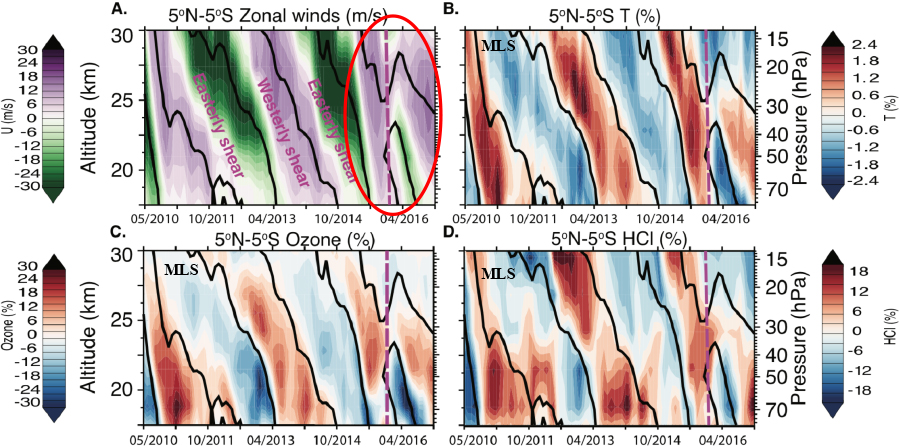
Time-pressure variations in (A) zonal mean zonal winds (in m/s), (B) temperature, (C) O3, and (D) HCl averaged over 5oN-5oS. O3, HCl and temperature are deseasonalized and values are shown as percent change from long-term monthly averages. The thick black contours denote zero wind shear and indicate the location of easterly and westerly vertical wind shear. The vertical magenta line corresponds to the date (February 2016) when anomalous easterly vertical shear appeared at 40 hPa.
Scientific significance, societal relevance, and relationships to future missions: The quasi-biennial oscillation (QBO) consists of alternating easterly (east-to-west) and westerly (west-to-east) directions of the wind in the tropical stratosphere with an average period of 28 months. Its pattern of alternating wind regimes has been observed since 1953 and is one of the most robust features of the tropical stratosphere. The QBO is the major source of the stratospheric year-to-year variability and its impact on stratospheric chemical constituents (such as ozone (O3), which shields all living organisms from harmful ultraviolet (UV) radiation, and hydrochloric acid (HCl), which provides chlorine atoms for fast ozone depletion) extends far beyond the tropics. Here, we demonstrate the unprecedented impact of recent QBO disruption on the composition of the stratosphere as evidenced in Aura MLS data of HCl, O3, and T. For instance, during the spring-summer 2016 tropical total column ozone increased and extratropical values were at or near record lows over the more than 40 years of the total ozone data (not shown). Calculations suggest that very low ozone at 22.5oS in August 2016, as a consequence of QBO disruption, increased the monthly surface clear-sky UV index by 8.5 % compared to the 36-yr average. It is unclear if this QBO disruption is an event of great rarity or if similar events will reoccur. A series of similar events with the same timing could potentially alter ozone and other trace gas distributions and lead to a long-term increase in the surface UV index during the peak of boreal summer, affecting the stratospheric climate and making it more difficult to accurately estimate climate trends. Today, no models with self-generating QBO are able to simulate this QBO disruption, pointing to an incomplete understanding of forcing mechanisms. This event, whether unique or the first of many QBO disruptions, emphasizes the crucial need to continue collecting and evaluating high quality satellite measurements to trace the impact of changes in the stratospheric circulation.
Instruments onboard NOAA's Joint Polar Satellite System (JPSS-2 and -3) will continue the O3 record of MLS, but there are currently no sensors planned to continue the MLS HCl measurements once Aura terminates. Aura was launched in 2004.
References: O. V. Tweedy, Kramarova, N. A., Strahan, S. E., Newman, P. A., Coy, L., Randel, W. J., Park, M., Waugh, D. W., and Frith, S. M. (2017). Response of trace gases to the disrupted 2015?2016 quasi-biennial oscillation. Atmos. Chem. Phys., 17(11):6813?6823, https://doi.org/10.5194/acp-17-6813-2017. P. Newman, Coy, L., Pawson, S., and Lait, L. (2016). The anomalous change in the QBO in 2015-2016, Geophys. Res. Lett., 43, 8791-8797, doi:10.1002/2016GL070373.
Data Sources: Aura MLS version 4.2 level 2 measurements of temperature (T), ozone (O3) and hydrochloric acid (HCl) are available from the NASA Goddard Space Flight Center Earth Sciences (GES) Data and Information Services Center (DISC). O3 and T are reported on a fixed vertical grid with 12 surfaces per decade change in pressure between 1000 and 1 hPa; HCl is reported on 6 pressures per decade. The MERRA-2 reanalysis of zonal wind fields were obtained from the NASA Earth Observing System Data and Information System( https://earthdata.nasa.gov; NASA, 2017).
12.28.2017